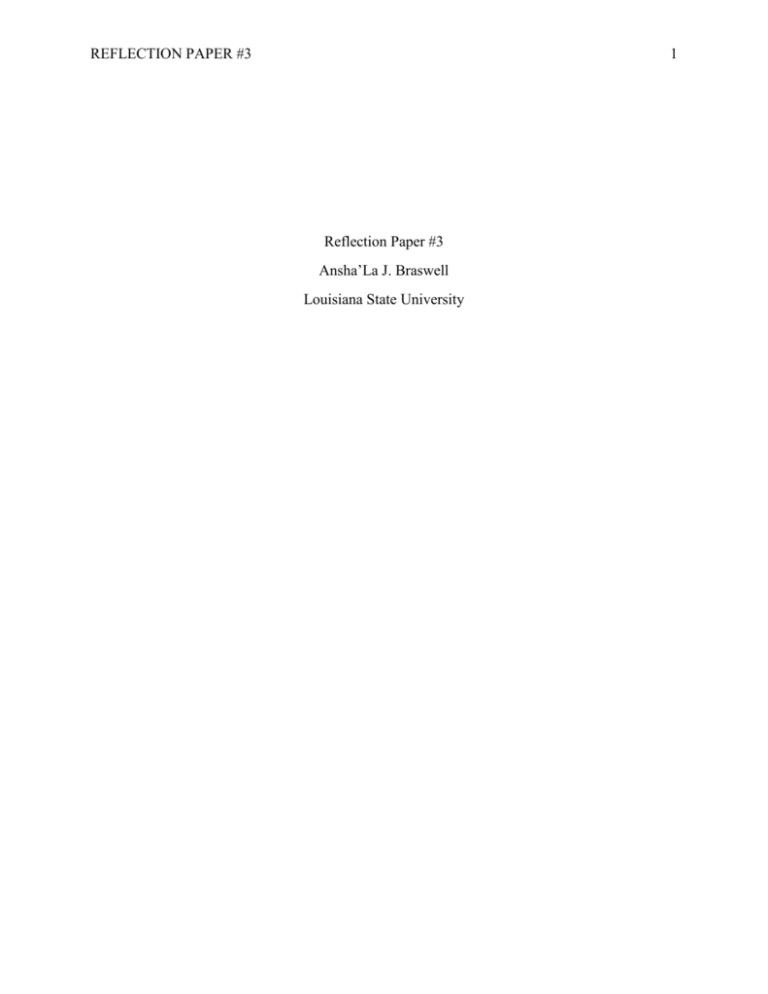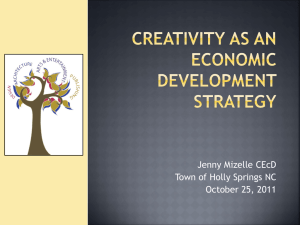File - Ansha`La Braswell
advertisement

REFLECTION PAPER #3 1 Reflection Paper #3 Ansha’La J. Braswell Louisiana State University REFLECTION PAPER #3 2 Holly is a young woman who returns to her childhood home in a state of extreme crisis. She is greeted at the door by her younger sister, Vanessa, who is shocked to see her after such an extended absence. Holly makes sure that her father is not in the home before she will even step foot into the residence. Holly then proceeds to rant to her sister about the horrible things that their father has done. As the clip goes on, we realize that this girl has definitely been abused and that she is still holding on to every bad thing that her father has done to her. I will attempt to critically examine family stress in Holly’s life by using course readings as research based support to aid me in analyzing her actions. I will focus on Holly’s crisis, the palliative behaviors that she exhibits, whether or not she is experiencing denial, her family myth, how boundary ambiguity is demonstrated in her family, and Holly’s situational meaning of being a member of this family. I will then close with a discussion of what I think eventually happens to Holly and her family. Holly and Crisis “What bedroom are you sleeping in these days,” Holly says before she goes into a line of questioning about her sister’s current sleeping arrangements. She goes on to ask Vanessa about a girl who had once been their neighbor and says that the girl could see into her bedroom. Holly cannot even bring herself to step foot into her old bedroom or give details about what really happened to her. When Holly proceeds to cry profusely, it definitely alludes to the fact that terrible things happened in her bedroom, perhaps of a sexual nature. Holly appears to be having some type of mental breakdown and it is clear that she is in a severe state of crisis. Crisis is defined as “disequilibrium so acute that one is immobilized, incapacitated, and unable to restore stability without a major change in family structure and patterns of interaction” (Crosbie-Burnett, 1989, p. 328). Patterson (2002) similarly defines crisis as “a period of significant disequilibrium and disorganization in a family” (p. 351). There are many signs that Holly is experiencing extreme crisis. For example, she paces around during this entire episode, she begins to cry multiple times when she talks about the tragic events of her past, she is inconsolable, and it is evident that the weight of her past is taking a toll on her mental health. “If a family sees an event as one it can handle, a crisis will be lessened or prevented; if a family sees an event as one it cannot handle, a crisis will occur REFLECTION PAPER #3 3 or be more severe” (Walker, 1985, p. 832). Holly clearly sees this event as one that she cannot handle, which is probably why she results to gun play. Demonstrations of Palliative Behaviors Holly demonstrates palliative behaviors as an attempt to temporarily decrease her intense stress. Palliative behaviors are actions or thoughts which make the person feel better about the situation for a short time, but it doesn’t actually alleviate the problem (Boss, 2002b). Holly thought that reminiscing about the past with her sister would help her come to terms with everything, but all it actually did was worsen her state. The more stories she told, the angrier she became. Holly thought that committing suicide or killing her father would help her situation. Of course that was the worst possible thing she could do. She would either kill herself and cease to exist or kill her father and have to deal with the guilt associated with that for the rest of her life. Denial Boss (2002b) defines denial as the refusal to believe what one sees or hears and the refusal to believe or accept a physical reality. “It is commonly accepted that denial is a defense mechanism in which external reality is rejected” (Boss, 2002b, p. 123). In my opinion, Vanessa is experiencing denial. She does not want to accept the severity of what her father has done to Holly and she writes off everything Holly says as just an exaggeration. It seems as if Vanessa is in denial about the fact that her father is a huge factor in why her sister is so messed up. When Holly says something negative about their father, Vanessa quickly takes up for him and tries to rationalize his actions. It seems as if just because the father hasn’t abused Vanessa, she denies the fact that he may have abused her sister. For example, when Holly said “If he’s not home there’s no reason to be scared,” Holly sighed and said, “Don’t start.” She brushes off the fact that Holly is literally afraid to go into the home. When Holly mentions that their father has not wanted to fix things, Vanessa takes up for him by saying, “He’s the one that’s wanted to talk to you forever, you’re the one who doesn’t want it.” This seems to imply that Vanessa believes that her father has tried everything and Holly is just being stubborn. Holly even picks up on this and tells her sister, “Don’t you patronize me…You know better!” REFLECTION PAPER #3 4 Holly’s Family Myth “If one were to ask one family member to report about family’s meanings, that person’s version would be his or her story, what Wamboldt and Wolin (1988) calls the ‘family myth,’ or what David Reiss (1989) calls the ‘represented family’” (Patterson and Garwick, 1994, p. 107). Holly’s family myth is that her father is a terrible man and that he scarred her for life. Holly believes that there is no way out of the pain that she is currently experiencing and that she was raised in the worst possible environment. Holly does not have a good concept of love because she perceives that she was not loved as a child. An example of this is Holly telling Vanessa, “You never know where love is going to show its ugly face.” Most people do not refer to love as ugly, but as a beautiful experience. The fact that Holly says that love has an ugly face means that she has not had a positive experience with it. Demonstrations of Boundary Ambiguity Boundary ambiguity is defined as “…the outcome of a situation of incongruence between physical and psychological presence in the family” (Boss, 2002b, p. 95). This family definitely appears to be experiencing boundary ambiguity in which there is physical absence and a psychological presence. Vanessa says that their father talks about Holly all the time and expresses his discontent with the state of their relationship regularly. We can tell that Holly has been gone for a while which means that she was physically gone, but psychologically present to Vanessa and their father. Another example can be inferred by Holly’s actions. Someone who is not mentally bothered by a situation will not rant about it continuously. I believe that even in Holly’s absence, she could not stop thinking about the pain of her childhood which is why she had to come back to confront her father. In this case, she was gone physically, but she could not mentally escape her father’s actions and the pain that he caused her. “If a family member is perceived as psychologically present, but is physically absent for a long time, the family boundary is ambiguous and cannot be maintained.” (Boss, 1980, p.194). Holly’s Situational Meaning A situational meaning develops when “family members talk with each about the stressful situation, they begin constructing meanings about the stressor event or the pileup of demands, as well as REFLECTION PAPER #3 5 their capabilities as a family to manage the demands” (Patterson and Garwick, 1994, p. 108). Holly has a distorted situational meaning because she has yet to sit down and have a conversation with her father about the pain that he has caused her. “Family disagreements threaten permanent splits and suppress communication. Secrets and silence are especially confusing to children, and without intervention will eventually cause anxiety and depression” (Boss, 2002a, p. 40). That profound statement describes exactly what Holly is currently experiencing. Luckily, situational meanings are the most responsive to change (Patterson and Garwick, 1994). For a positive change to happen, Holly and her family need to sit down with a therapist and get to the bottom of their dysfunction. Conclusion Holly is definitely at a low place in her life. She is experiencing a large amount of family stress and it seems as if she has hit her breaking point. The clip ends with Holly’s father walking into the home and Holly pulling out a gun. First, Holly points the gun at herself, then at her father, and then back at herself. As the scene fades to darkness we are all left wondering what eventually happens to Holly and her family. I believe that Holly will end up putting the gun down. In my opinion, if Holly really wanted to either kill herself or her father, she would have done so immediately after he entered the home. I think this was all a last desperate attempt for her father’s attention because all Holly really wants is for the pain to go away and for the relationship to somehow be mended. I think Holly will eventually listen to what her father has to say and I am sure he will offer a different perspective of what went on. I think Holly’s father will see just how much he hurt Holly and Holly will see just how sorry her father really is. I think that with Vanessa’s help, Holly and her father will find a way to put their past behind them and work towards a brighter future together. REFLECTION PAPER #3 6 References Boss, P. (1980). Normative family stress: Family boundary changes across the life span. In P. Boss & C. Mulligan (Ed.), In Family stress: Classic and contemporary readings (pp. 193-200). Thousand Oaks, CA: Sage. Boss, P. (2002a). Ambiguous loss in families of the missing. The Lancet, 360, 39-40. Boss, P. (2002b). Family stress management: A contextual approach (2nd ed.). Thousand Oaks, CA: Sage. Crosbie-Burnett, M. (1989). Application of family stress theory to remarriage: A model for assessing and helping stepfamilies. Family Relations, 38, 323-331. Patterson, J.M. & Garwick, A.W. (1994). Levels of meaning in family stress theory. In P. Boss & C. Mulligan (Ed.), In Family stress: Classic and contemporary readings (pp. 105-120). Thousand Oaks, CA: Sage. Patterson, J.M. (2002). Integrating family resilience and family stress theory. Journal of Marriage and Family, 64, 349-360. Reiss, D. (1981). The family’s construction of reality. Cambridge, MA: Harvard University Press. Walker, A. (1985). Reconceptualizing family stress. Journal of Marriage and the Family, 827-837. Wamboldt, F.S., & Wolin, S.J. (1988). Reality and myth in family life: Changes across generations. Journal of Psychotherapy and the Family, 4(1), 141-165.







